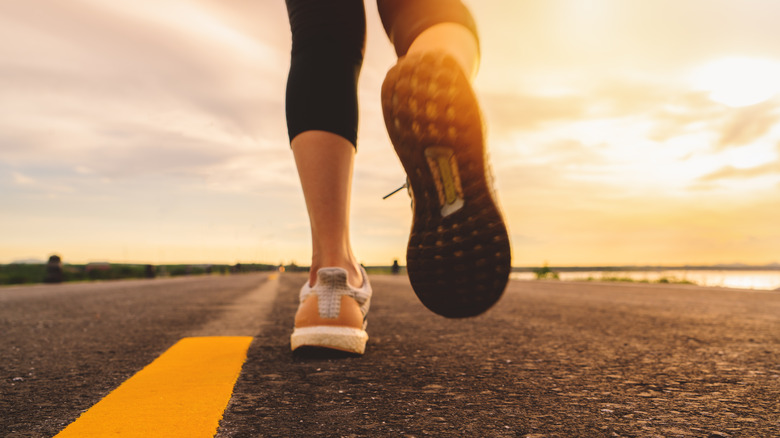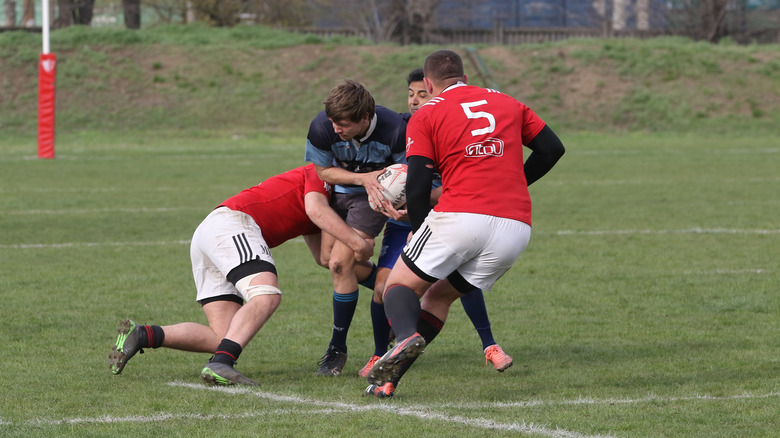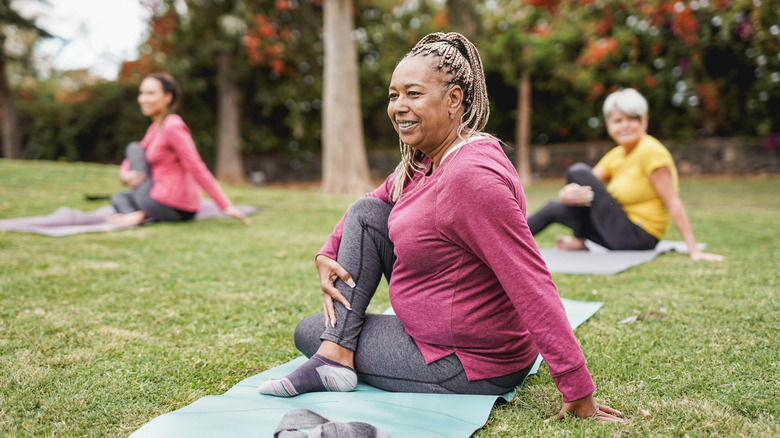The Best And Worst Sports For Your Health
Sports-related injuries are abundantly common. In fact, according to Healthgrades, 2 million people per year go to the hospital for some sort of sports-related injury. "injuries vary by sport," the site confirmed. Indeed, athletic trainers can attest to the fact that certain sports put athletes at greater risk of danger than others (via Time). This got us thinking — aside from the traditional concussions caused by high-impact activities, which sports have the highest incidence of injury? Furthermore, what future health repercussions do these injuries have on athletes and even recreational participants?
Health Digest did the research to provide you with the tools you need to exercise safely. After all, movement is one of the keys to a long, healthy life. As we age, the list of nagging injuries tends to mount, unfortunately. With this in mind, we bring you the best — and absolute worst — sports for your health.
Worst: Basketball
It may come as a surprise to learn that basketball is actually worse for your health than many other recreational options. The pros of this court sport are great. Unfortunately, the risk of injury is greater. Basketball is a high-intensity, contact sport that demands a lot of physicality from those who choose to play it.
The most notable injuries that occur in basketball are sprained ankles and jammed fingers. These injuries are not life-threatening, but both can linger and cause pain and annoyance for years. Because basketball is high impact by nature, many ballers find themselves with debilitating spinal injuries as they age. The short bursts of running, excessive jumping, and occasional hits from other athletes can add up over time. All of this abuse can culminate in disk degeneration, ruptured disks, and loss of elasticity (via San Francisco Chronicle).
Unless you're Steph Curry (go, Warriors!), it is probably best to play basketball with a side of therapeutic exercise. Maintaining flexibility and even strength will help negate some of the negative effects of basketball.
Best: Cycling
While competitive road biking can have serious consequences, it is ultimately one of the best sports for overall health. Not only is it an environmentally friendly option, but the health benefits that stand to be gained are huge. Most notably, cycling is a low-impact option that can aid in weight management. Beneath the surface, the cardiovascular impacts are cycling are great. Consistent bike riding can decrease your risk of developing type 2 diabetes. Additionally, hopping in the saddle can lower your risk of a future heart attack or stroke significantly (via Healthline).
Cycling, as with most sports, increases your circulation and allows your body to produce endorphins. These aspects lead to better mental health. Whether in spin class or out in the world, riding your bike increases your leg and core strength — a strong core aids in preventing lower back pain as you age, which is a huge plus. Bike riding is also great for beginners. Because it is low impact and can be self-paced, you can monitor your own biofeedback and adjust accordingly. Anyone recovering from cancer, a traumatic injury, or just looking to increase their fitness will benefit from hopping in the saddle (per Healthline).
Worst: Boxing
People love to watch boxing and MMA. In part, this may be due to the gruesome injuries and blows the athletes sustain. Unsurprisingly, getting hit in the head and face repeatedly is not good for your health. According to the American Association of Neurological Surgeons, 90% of boxers experience a traumatic brain injury at least once in their career (via Neurologic Rehabilitation Institute at Brookhaven Hospital). They speculate that the number of boxers suffering from brain injury is far greater than reported and recorded.
Boxers are more susceptible to brain-related diseases due to the number of blows they endure (via NRI). These include Parkinson's disease and Alzheimer's disease. As Verywell Fit explained, boxers tend to have less white matter in their brains, which is usually smaller with thinner grey matter than non-boxers. White matter is found deep within the brain. It contains nerve axons, many of which are covered by myelin. Myelin acts as a sheath to encase and protect nerve fibers from damage (via Medline Plus).
In addition to concussions and brain injuries, boxers often suffer from significant eye and teeth injuries, broken ribs, and regular internal bleeding. Damage often occurs to organ systems as well (via Verywell Fit). All in all, boxing might seem cool, but there are other sports that better support healthful aging.
Best: Tennis
There is a reason we see so many seniors wielding racquets: Tennis is a wonderful sport that is great for your health. Playing tennis supports a healthy cardiovascular system. By regularly running up and down the court, pivoting, and practicing your jump serves, you encourage your heart to beat more efficiently. From a physiological standpoint, this increases the amount of oxygen being circulated through your body, which is great for health and disease prevention (via Verywell Fit).
Hitting the courts regularly can help you develop coordination, agility, and fine-tuned motor skills. As we age, proprioception is one of the first things that starts to degenerate. It is wildly beneficial to soak up the balance benefits of tennis. Regularly swinging a racquet can help you maintain your strength and keep your range of motion healthy. Tennis is an accessible sport to newbies looking to give fitness a try.
Many people join tennis clubs or play with loved ones. Playing outside while soaking up vitamin D surrounded by a community is a surefire way to ensure health as you age (per Verywell Fit). We totally get why Venus and Serena have stuck with it for so long.
Worst: Luge
We get it — you probably only think about luge as a sport once when the Winter Olympic Games roll around. However, when it comes to sports that can shorten your lifespan and cause irrevocable damage, luge is high atop the list.
Lugers lie supine on a sled without brakes and launch themselves down a long, icy chute. They often reach speeds of 90 miles per hour even though their only protection is a helmet. If all goes well, luging isn't so bad. But one wrong move can have long-lasting health consequences via (The Washington Post). Luge crashes are not exactly uncommon, and they happen during training and, occasionally, during the Olympic Games themselves. The most notable accident occurred during an Olympic training run in Whistler, Canada, in February 2010. Georgian luger Nodar Kumaritashvili suffered a fatal crash.
Additionally, Emily Sweeney, an American luger, fractured her neck and back during the Olympic games in 2018, AP News reported. While she has since recovered, it is important to note how high the stakes are in this slippery sport. While most people do not participate in luge on a day-to-day basis, it remains cemented on our list as one of the worst sports for your health.
Best: Running
There is always someone walking around telling you how bad running is for your body. We are pleased to inform you that despite extreme runners' tendency to overdo it, running is actually one of the most healthful sports! Running is a high-impact activity, which implies that its health benefits are best soaked up in moderation. As Healthline explained, just five to 10 minutes of running every day can lower your risk of developing cardiovascular diseases. Conversely, these benefits seem to top out at 4.5 hours per week, so if you don't feel like tackling Western States right now, you can still reap the many benefits of jogging.
Research shows that moderate running every day can increase your natural longevity and weight management (per Healthline). Experts recommend incorporating cross-training, such as swimming, to balance out the impact of running. With regular core strengthening exercises, rest days, and flexibility work, there is no reason that you won't be able to run as an octogenarian.
Worst: Cheerleading
Cheerleading is just a bunch of jumping and waving pompoms around, right? Not so. Cheerleading is yet another activity high atop the list of the most dangerous sports. Don't let the frilly countenance fool you — some of the injuries that cheerleaders sustain are on par with boxers and professional basketball players. In fact, between 1980 and 2013, cheerleading injury rates rose by 440% (via Active Kids). This is because, even in practice, cheerleaders do not wear any protective gear. Many of the other worst sports for your health follow this trend.
From human pyramids to stunts that have your mom on the edge of her seat, cheerleaders have been known to fly high ... and hit the ground hard if one wrong move is made. Experts estimate over 50% of catastrophic female injuries from sport occur on the sidelines of spectator sports. Some cheerleading injuries include your run-of-the-mill wrist and ankle sprains, but more severe injuries are frighteningly common. Spinal column and skull fractures occur regularly, in addition to injuries to the spinal cord itself. The high incidence of traumatic injury is why cheerleading is one of the worst sports for your health.
Best: Rock climbing
If you are unfamiliar with rock climbing, it may seem like the most dangerous sport in the world. Once you start to dig your hands into some crags, though, you'll realize how wrong you are. As with many other great sports for your health, rock climbing comes with its own bag of risks. When properly and safely executed, though, rock climbing has proven to be one of the best sports for overall mental and physical health (via HuffPost).
Rock climbing boosts brain function, as each crux is a puzzle in itself. Sending a tough route boosts your endurance, strength, and flexibility. Those are the three fundamental components of fitness, so finding a sport that uses all three is epic. Rock climbing teaches valuable life lessons, such as patience and perseverance. When done outside, rock climbing can boost vitamin D and reduce stress levels. The climbing community is tight-knit and encouraging, yet another healthful benefit of this gravity-defying sport.
Worst: Soccer
Soccer is a surprising sport to grace the list of the worst sports for your health. Much like other contact sports, soccer is a fast-paced, high-intensity game played with little protective gear. Because of these conditions, concussions are common (via Stop Sports Injuries). Many soccer players end up in kerfuffles over the ball that end in fractured bones. Broken bones, especially when left to heal without medical attention, put you at a higher risk for developing arthritis later in life. Since soccer is a kicking sport, many players suffer blows to the shins and lower extremities.
Still, compared to some of the other worst sports for your health, soccer may seem fairly tame. But the reason that soccer ended up on this list is due to the impact of the injuries sustained on aging bodies. Concussions can increase your risk of developing a neurodegenerative disease (per Cognitive Fx). This is in addition to the bone issues adults have after cracking one too many in AYSO.
Best: Hiking
Hiking is pretty great. You get to enjoy time outside, look for wildlife, focus your mind, and sometimes you get to do all of that with your friends or family. But hiking's benefits far outweigh what is visible on the surface.
Not only does hiking improve your balance and strength, but it can help control weight issues and provide necessary endorphins for mood-boosting. Hiking is an excellent way to lower your blood pressure and regulate your blood sugar levels. Both have lasting health benefits that will serve you now and as you age. Additionally, hiking is a low-impact activity. And since it is a weight-bearing activity, unlike cycling, there are deeper benefits as well. Bone deep that is. Hiking can help boost your bone density and aid in decreasing your risk of developing osteoporosis (via WebMD). With all of these great reasons to hike, we cannot think of a reason not to hop outside every day. The mountains are calling, and we must go.
Worst: Gymnastics
At this point, it's pretty safe to say that most sports that require flying through the air without protective padding top the list of the worst sports for your health. While gymnastics is dangerous, it made the list for a different reason.
Gymnastics is one of the worst sports for your health because of the effects it can have on young kids who practice it. Broken bones in growing children can impact their growth plates and alter growth. Young children who practice and compete in gymnastics often have stunted growth due to the environment's rigorous training and extreme stress. What's more, many young gymnasts are under pressure to diet for aesthetic purposes. This drives many athletes deep into eating disorder territory. This dark bag of prevalent problems in the gymnastic community can all lead to disease and health-related issues in adulthood. A child who competes in gymnastics is more likely to develop endocrine problems, as well as cardiovascular and respiratory issues as they age (via SportsRec).
Best: Swimming
Swimming is arguably the best sport for your health. It is more than a low-impact exercise; the water supports the weight of your body. This makes swimming excellent for people who are rehabilitating injuries or have joint pain when exercising on land. Swimming is a full-body workout, and a quick few laps can torch calories beyond your wildest dreams (via Healthline). We love knowing that all of our many muscles are engaging as we swim.
Additionally, many swimmers find that the sport allows them to be more present, more relaxed, and less stressed as they move through their daily lives. Swimming can help boost your metabolic rate, which in turn provides you with more energy. Some people hate to sweat, but that isn't a problem when you are submerged in water for your workout (via Swimming.org).
In addition to all of these exceptional benefits, swimming also allows your body to produce the ultimate mood-boosting neurotransmitters: endorphins. Or should we say endolphins? Splish splash.
Worst: Rugby
Rugby is yet another full-contact sport that is played without padding. Rugby almost makes soccer look soft. This aggressive, tackle take-down sport is played without helmets, even though concussion is common. As with all contact sports, rugby can leave lasting effects long after the bruising has faded.
The gentler injuries typically associated with rugby include overuse injuries such as tendonitis and bursitis. If these ailments are left untreated, they can morph into chronic problems over time. Since rugby generally consists of people running after you and trying to take you down, impact injuries occur on the field frequently. Often, this includes broken bones and dislocated joints. These hard hits are often the cause of concussions, of which many rugby players have multiple (via Stop Sports Injuries). As we've seen time and time again, injuries often translate to future health problems. The cardio effects of rugby are healthful in your 20s, but the tumbles taken can be commemorated within your body forever. This is why rugby ranks high atop the list of the worst sports for your health.
Best: Cross-country skiing
If the thought of bundling up to go running in a snowstorm sounds terrible to you, we hear you. But slap some cross-country skis on those feet and get to work! Cross-country skiing is yet another sport that has incredible health benefits.
Cross-country skiing can look graceful from the sidelines, but if you are the one in motion, the burn is real. Olympic champion Rosie Brennan told Shape that cross-country skiing works every single muscle in your body. And we believe it! You use your upper body to drive your poles into the ground cover and your core, glutes, and hips for stabilization. Your legs propel you forward, often over semi-hilly terrain at high speeds (via Shape).
Cross-country skiing boasts many of the same benefits as other healthy sports. It is easy on your joints, can be done by athletes of any skill level, and seriously boosts your cardio work capacity. A short cross-country skiing sesh torches calories and can lead to better mental health (per Shape). Frigid temps be damned, we need some skis!
Worst: BASE jumping
No surprise here, right? One of the worst sports for your health is BASE jumping (leaping from a building, antenna, span, or Earth) — aka free-falling off of really high s***. BASE jumpers leap into the abyss with only a parachute to ensure they have a safe landing. Of course, they do usually have a backup parachute. Unlike skydiving and other parachute-involving sports, there is often not enough time to deploy the safety parachute if the first one fails, according to Rules of Sport.
BASE jumping is absolutely at the top of the list, even though there are no real health issues from it — if you live. Instead, BASE jumping is on the list because the rate of death among these jumpers is mind-numbingly high. After all, death is the worst health effect of any sport! As Rules of Sport explained, one death occurs per every 2,317 BASE jumps. This can be directly compared with skydiving: Your risk of death during a skydiving venture is one is 101,083.
To add insult to life-ending injury, BASE jumping is illegal in most parts of the world. This inspires base jumpers to carry out covert ops without any alerted medical personnel or a safety team.
Best: Yoga
Though yoga may not immediately come to mind when considering athletics, it is one of the best activities you can do for your health. According to Johns Hopkins Medicine, yoga can aid in the improvement of the three components of fitness: strength, flexibility, and cardiovascular capacity.
With regular practice, yoga can help improve your strength, balance, and coordination. All of these elements are necessary to keep up with as we age. Yoga is also an excellent community-centered activity. Being involved in a like-minded community has been proven to have massive health benefits (via CDC). Furthermore, yoga can help ease the symptoms of many diseases and conditions. For example, regularly practicing yoga can help relieve back pain and pain from arthritis (per Johns Hopkins Medicine).
Yoga can help reduce stress, anxiety, and tension. Plus, practicing it consistently can lead to more energy. Best of all, yoga is completely modifiable and gentle, explained Johns Hopkins. This means that it is one of many excellent sports for your health as you age!

















